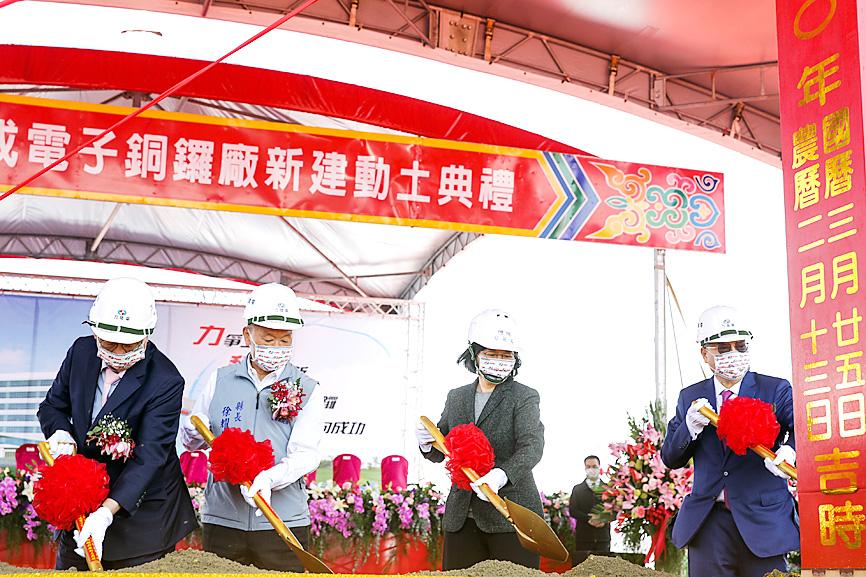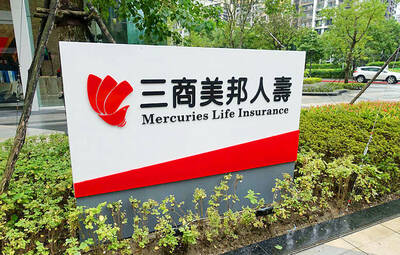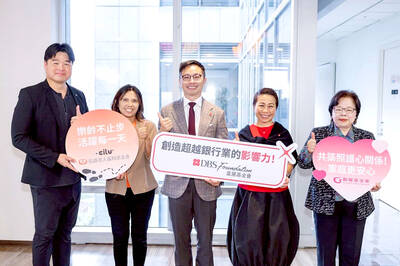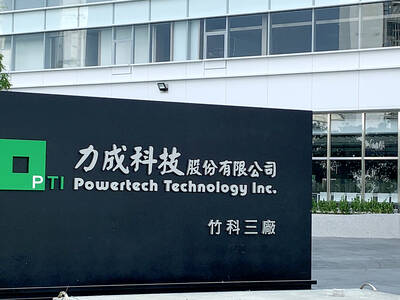Powerchip Semiconductor Manufacturing Corp (力積電) yesterday held a groundbreaking ceremony for a NT$278 billion (US$9.72 billion) fab in Miaoli County, to raise capacity as it is struggling to keep up with demand for its chips.
Chip shortages earlier this year suspended operations at some vehicle factories and forced some smartphone makers to phase out lower-end models ahead of schedule.
“All our product lines are fully utilized. We expect that the situation will last through the end of next year at least. So we have to build a new fab,” Powerchip chairman Frank Huang (黃崇仁) said on the sidelines of the ceremony.

Photo: Bloomberg
The severe shortage has led to an increase in chip prices of 30 to 40 percent since the end of last year, Huang said, adding that he expects that prices would increase further, with a new wave of hikes as early as next month.
“I have been working in the semiconductor industry for a long time, but I have never seen any structural shortage like this before,” he said.
The supply-demand disparity comes as almost no investment has over the past few years been made by the world’s major chipmakers in certain high-demand segments, Huang said.
While major chipmakers have invested in advanced technologies, such as 3-nanometer technology developed by Taiwan Semiconductor Manufacturing Co (台積電), they did not invest in less advanced technologies, which are also used in electric vehicles, Internet-of-Things equipment and 5G devices, he said.
Powerchip’s new fab in the Tongluo Science Park (銅鑼科學園區) would from 2023 make chips with 45-nanometer and 50-nanometer technologies, Huang said.
Management ICs, touch sensors, vehicle chips and driver ICs for flat panels would be made at the new fab, he said.
In its first phase, the fab would produce 25,000 12-inch wafers per month, before capacity would be raised to 100,000 wafers per month, Powerchip said.
The fab would create 3,000 new jobs and, when fully utilized, generate NT$60 billion in production value, it said.
Huang said that Taiwan offers the most competitive environment for semiconductor firms, with production costs lower than in other countries, including China.
“For decades, Taiwan has been a trusted manufacturer of semiconductors,” American Institute in Taiwan Director Brent Christensen said at the ceremony.
President Tsai Ing-wen (蔡英文) has identified the semiconductor industry as a strategic priority, not only for economic innovation, but also for national security, Christensen said, adding that the US government agrees with that view.
Last month, as one of his first executive orders, US President Joe Biden launched a review process of supply chains for critical and essential goods to make them more resilient and safe, Christensen said.
Building resilience for the US means increasing domestic production of certain equipment, he said.
However, that would also entail closer cooperation with trusted partners that share the same values as the US, Christensen said, adding that this would ensure that supply chain access cannot be leveraged against the US.
To forge stronger economic ties with Taiwan, as well as ties in fields of cooperation, the two nations last year launched the US-Taiwan Economic Prosperity Partnership Dialogue, Christensen said.
The dialogue is part of a broader coalition to counter China’s unfair economic and investment policies, he said.
Christensen also encouraged investment from Taiwanese semiconductors companies across the entire value chain — design, foundries, assembly and supply.

Mercuries Life Insurance Co (三商美邦人壽) shares surged to a seven-month high this week after local media reported that E.Sun Financial Holding Co (玉山金控) had outbid CTBC Financial Holding Co (中信金控) in the financially strained insurer’s ongoing sale process. Shares of the mid-sized life insurer climbed 5.8 percent this week to NT$6.72, extending a nearly 18 percent rally over the past month, as investors bet on the likelihood of an impending takeover. The final round of bidding closed on Thursday, marking a critical step in the 32-year-old insurer’s search for a buyer after years of struggling to meet capital adequacy requirements. Local media reports

US sports leagues rushed to get in on the multi-billion US dollar bonanza of legalized betting, but the arrest of an National Basketball Association (NBA) coach and player in two sprawling US federal investigations show the potential cost of partnering with the gambling industry. Portland Trail Blazers coach Chauncey Billups, a former Detroit Pistons star and an NBA Hall of Famer, was arrested for his alleged role in rigged illegal poker games that prosecutors say were tied to Mafia crime families. Miami Heat guard Terry Rozier was charged with manipulating his play for the benefit of bettors and former NBA player and

The DBS Foundation yesterday announced the launch of two flagship programs, “Silver Motion” and “Happier Caregiver, Healthier Seniors,” in partnership with CCILU Ltd, Hondao Senior Citizens’ Welfare Foundation and the Garden of Hope Foundation to help Taiwan face the challenges of a rapidly aging population. The foundation said it would invest S$4.91 million (US$3.8 million) over three years to foster inclusion and resilience in an aging society. “Aging may bring challenges, but it also brings opportunities. With many Asian markets rapidly becoming super-aged, the DBS Foundation is working with a regional ecosystem of like-minded partners across the private, public and people sectors

BREAKTHROUGH TECH: Powertech expects its fan-out PLP system to become mainstream, saying it can offer three-times greater production throughput Chip packaging service provider Powertech Technology Inc (力成科技) plans to more than double its capital expenditures next year to more than NT$40 billion (US$1.31 billion) as demand for its new panel-level packaging (PLP) technology, primarily used in chips for artificial intelligence (AI) applications, has greatly exceeded what it can supply. A significant portion of the budget, about US$1 billion, would be earmarked for fan-out PLP technology, Powertech told investors yesterday. Its heavy investment in fan-out PLP technology over the past 10 years is expected to bear fruit in 2027 after the technology enters volume production, it said, adding that the tech would